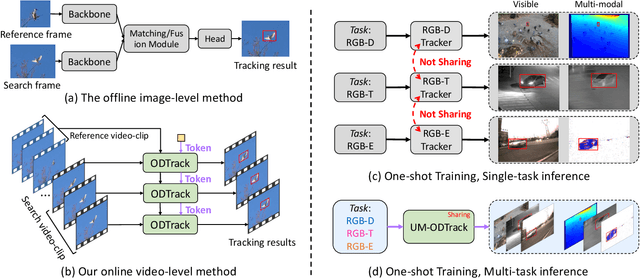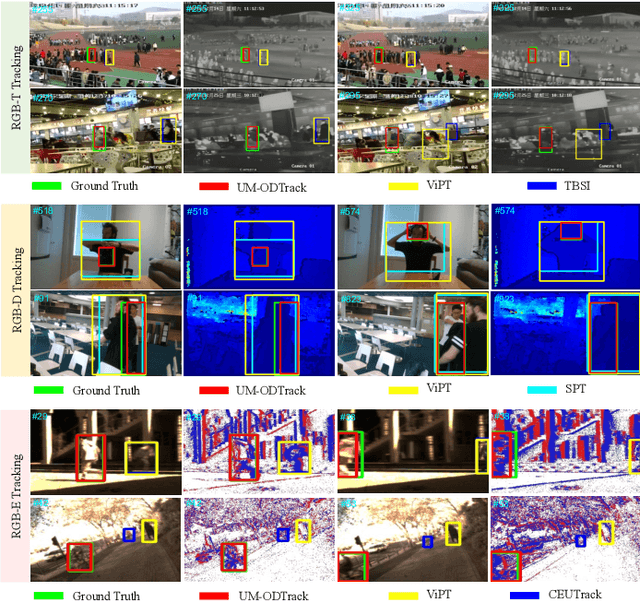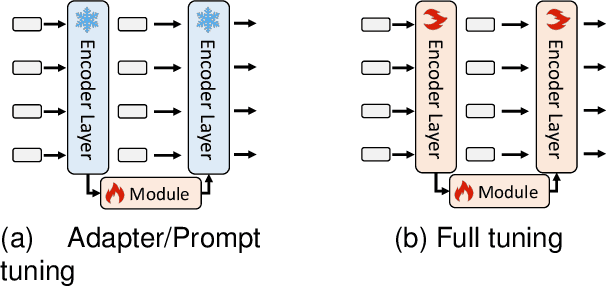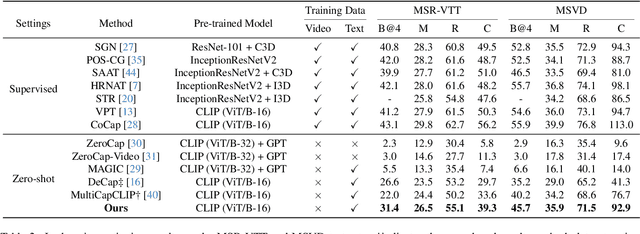Guorong Li
Towards Universal Modal Tracking with Online Dense Temporal Token Learning
Jul 27, 2025



Abstract:We propose a universal video-level modality-awareness tracking model with online dense temporal token learning (called {\modaltracker}). It is designed to support various tracking tasks, including RGB, RGB+Thermal, RGB+Depth, and RGB+Event, utilizing the same model architecture and parameters. Specifically, our model is designed with three core goals: \textbf{Video-level Sampling}. We expand the model's inputs to a video sequence level, aiming to see a richer video context from an near-global perspective. \textbf{Video-level Association}. Furthermore, we introduce two simple yet effective online dense temporal token association mechanisms to propagate the appearance and motion trajectory information of target via a video stream manner. \textbf{Modality Scalable}. We propose two novel gated perceivers that adaptively learn cross-modal representations via a gated attention mechanism, and subsequently compress them into the same set of model parameters via a one-shot training manner for multi-task inference. This new solution brings the following benefits: (i) The purified token sequences can serve as temporal prompts for the inference in the next video frames, whereby previous information is leveraged to guide future inference. (ii) Unlike multi-modal trackers that require independent training, our one-shot training scheme not only alleviates the training burden, but also improves model representation. Extensive experiments on visible and multi-modal benchmarks show that our {\modaltracker} achieves a new \textit{SOTA} performance. The code will be available at https://github.com/GXNU-ZhongLab/ODTrack.
SDVPT: Semantic-Driven Visual Prompt Tuning for Open-World Object Counting
Apr 24, 2025



Abstract:Open-world object counting leverages the robust text-image alignment of pre-trained vision-language models (VLMs) to enable counting of arbitrary categories in images specified by textual queries. However, widely adopted naive fine-tuning strategies concentrate exclusively on text-image consistency for categories contained in training, which leads to limited generalizability for unseen categories. In this work, we propose a plug-and-play Semantic-Driven Visual Prompt Tuning framework (SDVPT) that transfers knowledge from the training set to unseen categories with minimal overhead in parameters and inference time. First, we introduce a two-stage visual prompt learning strategy composed of Category-Specific Prompt Initialization (CSPI) and Topology-Guided Prompt Refinement (TGPR). The CSPI generates category-specific visual prompts, and then TGPR distills latent structural patterns from the VLM's text encoder to refine these prompts. During inference, we dynamically synthesize the visual prompts for unseen categories based on the semantic correlation between unseen and training categories, facilitating robust text-image alignment for unseen categories. Extensive experiments integrating SDVPT with all available open-world object counting models demonstrate its effectiveness and adaptability across three widely used datasets: FSC-147, CARPK, and PUCPR+.
P2Object: Single Point Supervised Object Detection and Instance Segmentation
Apr 10, 2025Abstract:Object recognition using single-point supervision has attracted increasing attention recently. However, the performance gap compared with fully-supervised algorithms remains large. Previous works generated class-agnostic \textbf{\textit{proposals in an image}} offline and then treated mixed candidates as a single bag, putting a huge burden on multiple instance learning (MIL). In this paper, we introduce Point-to-Box Network (P2BNet), which constructs balanced \textbf{\textit{instance-level proposal bags}} by generating proposals in an anchor-like way and refining the proposals in a coarse-to-fine paradigm. Through further research, we find that the bag of proposals, either at the image level or the instance level, is established on discrete box sampling. This leads the pseudo box estimation into a sub-optimal solution, resulting in the truncation of object boundaries or the excessive inclusion of background. Hence, we conduct a series exploration of discrete-to-continuous optimization, yielding P2BNet++ and Point-to-Mask Network (P2MNet). P2BNet++ conducts an approximately continuous proposal sampling strategy by better utilizing spatial clues. P2MNet further introduces low-level image information to assist in pixel prediction, and a boundary self-prediction is designed to relieve the limitation of the estimated boxes. Benefiting from the continuous object-aware \textbf{\textit{pixel-level perception}}, P2MNet can generate more precise bounding boxes and generalize to segmentation tasks. Our method largely surpasses the previous methods in terms of the mean average precision on COCO, VOC, SBD, and Cityscapes, demonstrating great potential to bridge the performance gap compared with fully supervised tasks.
The Devil is in the Distributions: Explicit Modeling of Scene Content is Key in Zero-Shot Video Captioning
Mar 31, 2025



Abstract:Zero-shot video captioning requires that a model generate high-quality captions without human-annotated video-text pairs for training. State-of-the-art approaches to the problem leverage CLIP to extract visual-relevant textual prompts to guide language models in generating captions. These methods tend to focus on one key aspect of the scene and build a caption that ignores the rest of the visual input. To address this issue, and generate more accurate and complete captions, we propose a novel progressive multi-granularity textual prompting strategy for zero-shot video captioning. Our approach constructs three distinct memory banks, encompassing noun phrases, scene graphs of noun phrases, and entire sentences. Moreover, we introduce a category-aware retrieval mechanism that models the distribution of natural language surrounding the specific topics in question. Extensive experiments demonstrate the effectiveness of our method with 5.7%, 16.2%, and 3.4% improvements in terms of the main metric CIDEr on MSR-VTT, MSVD, and VATEX benchmarks compared to existing state-of-the-art.
Less is More: Token Context-aware Learning for Object Tracking
Jan 01, 2025Abstract:Recently, several studies have shown that utilizing contextual information to perceive target states is crucial for object tracking. They typically capture context by incorporating multiple video frames. However, these naive frame-context methods fail to consider the importance of each patch within a reference frame, making them susceptible to noise and redundant tokens, which deteriorates tracking performance. To address this challenge, we propose a new token context-aware tracking pipeline named LMTrack, designed to automatically learn high-quality reference tokens for efficient visual tracking. Embracing the principle of Less is More, the core idea of LMTrack is to analyze the importance distribution of all reference tokens, where important tokens are collected, continually attended to, and updated. Specifically, a novel Token Context Memory module is designed to dynamically collect high-quality spatio-temporal information of a target in an autoregressive manner, eliminating redundant background tokens from the reference frames. Furthermore, an effective Unidirectional Token Attention mechanism is designed to establish dependencies between reference tokens and search frame, enabling robust cross-frame association and target localization. Extensive experiments demonstrate the superiority of our tracker, achieving state-of-the-art results on tracking benchmarks such as GOT-10K, TrackingNet, and LaSOT.
MambaLCT: Boosting Tracking via Long-term Context State Space Model
Dec 18, 2024



Abstract:Effectively constructing context information with long-term dependencies from video sequences is crucial for object tracking. However, the context length constructed by existing work is limited, only considering object information from adjacent frames or video clips, leading to insufficient utilization of contextual information. To address this issue, we propose MambaLCT, which constructs and utilizes target variation cues from the first frame to the current frame for robust tracking. First, a novel unidirectional Context Mamba module is designed to scan frame features along the temporal dimension, gathering target change cues throughout the entire sequence. Specifically, target-related information in frame features is compressed into a hidden state space through selective scanning mechanism. The target information across the entire video is continuously aggregated into target variation cues. Next, we inject the target change cues into the attention mechanism, providing temporal information for modeling the relationship between the template and search frames. The advantage of MambaLCT is its ability to continuously extend the length of the context, capturing complete target change cues, which enhances the stability and robustness of the tracker. Extensive experiments show that long-term context information enhances the model's ability to perceive targets in complex scenarios. MambaLCT achieves new SOTA performance on six benchmarks while maintaining real-time running speeds.
GaGA: Towards Interactive Global Geolocation Assistant
Dec 12, 2024Abstract:Global geolocation, which seeks to predict the geographical location of images captured anywhere in the world, is one of the most challenging tasks in the field of computer vision. In this paper, we introduce an innovative interactive global geolocation assistant named GaGA, built upon the flourishing large vision-language models (LVLMs). GaGA uncovers geographical clues within images and combines them with the extensive world knowledge embedded in LVLMs to determine the geolocations while also providing justifications and explanations for the prediction results. We further designed a novel interactive geolocation method that surpasses traditional static inference approaches. It allows users to intervene, correct, or provide clues for the predictions, making the model more flexible and practical. The development of GaGA relies on the newly proposed Multi-modal Global Geolocation (MG-Geo) dataset, a comprehensive collection of 5 million high-quality image-text pairs. GaGA achieves state-of-the-art performance on the GWS15k dataset, improving accuracy by 4.57% at the country level and 2.92% at the city level, setting a new benchmark. These advancements represent a significant leap forward in developing highly accurate, interactive geolocation systems with global applicability.
ClickTrack: Towards Real-time Interactive Single Object Tracking
Nov 24, 2024



Abstract:Single object tracking(SOT) relies on precise object bounding box initialization. In this paper, we reconsidered the deficiencies in the current approaches to initializing single object trackers and propose a new paradigm for single object tracking algorithms, ClickTrack, a new paradigm using clicking interaction for real-time scenarios. Moreover, click as an input type inherently lack hierarchical information. To address ambiguity in certain special scenarios, we designed the Guided Click Refiner(GCR), which accepts point and optional textual information as inputs, transforming the point into the bounding box expected by the operator. The bounding box will be used as input of single object trackers. Experiments on LaSOT and GOT-10k benchmarks show that tracker combined with GCR achieves stable performance in real-time interactive scenarios. Furthermore, we explored the integration of GCR into the Segment Anything model(SAM), significantly reducing ambiguity issues when SAM receives point inputs.
Click; Single Object Tracking; Video Object Segmentation; Real-time Interaction
Nov 20, 2024



Abstract:Single object tracking(SOT) relies on precise object bounding box initialization. In this paper, we reconsidered the deficiencies in the current approaches to initializing single object trackers and propose a new paradigm for single object tracking algorithms, ClickTrack, a new paradigm using clicking interaction for real-time scenarios. Moreover, click as an input type inherently lack hierarchical information. To address ambiguity in certain special scenarios, we designed the Guided Click Refiner(GCR), which accepts point and optional textual information as inputs, transforming the point into the bounding box expected by the operator. The bounding box will be used as input of single object trackers. Experiments on LaSOT and GOT-10k benchmarks show that tracker combined with GCR achieves stable performance in real-time interactive scenarios. Furthermore, we explored the integration of GCR into the Segment Anything model(SAM), significantly reducing ambiguity issues when SAM receives point inputs.
Retrieval Enhanced Zero-Shot Video Captioning
May 11, 2024



Abstract:Despite the significant progress of fully-supervised video captioning, zero-shot methods remain much less explored. In this paper, we propose to take advantage of existing pre-trained large-scale vision and language models to directly generate captions with test time adaptation. Specifically, we bridge video and text using three key models: a general video understanding model XCLIP, a general image understanding model CLIP, and a text generation model GPT-2, due to their source-code availability. The main challenge is how to enable the text generation model to be sufficiently aware of the content in a given video so as to generate corresponding captions. To address this problem, we propose using learnable tokens as a communication medium between frozen GPT-2 and frozen XCLIP as well as frozen CLIP. Differing from the conventional way to train these tokens with training data, we update these tokens with pseudo-targets of the inference data under several carefully crafted loss functions which enable the tokens to absorb video information catered for GPT-2. This procedure can be done in just a few iterations (we use 16 iterations in the experiments) and does not require ground truth data. Extensive experimental results on three widely used datasets, MSR-VTT, MSVD, and VATEX, show 4% to 20% improvements in terms of the main metric CIDEr compared to the existing state-of-the-art methods.
 Add to Chrome
Add to Chrome Add to Firefox
Add to Firefox Add to Edge
Add to Edge